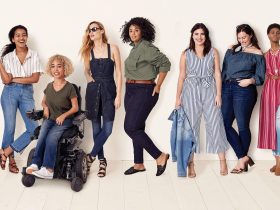As teh world grapples with the pressing challenges of climate change, resource depletion, adn environmental degradation, the quest for sustainable solutions has never been more urgent.Among the myriad of industries that contribute to our ecological footprint, fashion stands out, not only for its environmental impact but also for its potential to led the charge toward a greener tomorrow.
In this article, we’ll explore how the fashion industry is evolving, embracing innovative practices and materials that prioritize sustainability without sacrificing style. From eco-friendly fabrics to circular production models, we aim to shed light on the transformative changes taking place and how both consumers and brands can play a pivotal role in shaping a more sustainable future. Join us on this journey to discover how the choices we make in fashion can ripple outward, influencing a healthier planet for generations to come.
Exploring Sustainable Materials: The heart of Eco-Friendly Fashion

In the pursuit of a more sustainable future, the fashion industry is undergoing a transformative shift towards innovative materials that minimize environmental impact.Designers are increasingly embracing eco-friendly fabrics, derived from renewable resources or recycled materials, to craft stylish yet responsible clothing. Some noteworthy options include:
- Organic Cotton: Grown without harmful pesticides, making it gentler on the planet.
- Tencel: Made from sustainably sourced wood pulp, known for its soft feel and biodegradability.
- Recycled Polyester: Created from plastic bottles and waste, reducing landfill contributions.
The integration of these sustainable materials is not merely a passing trend but a vital step toward fostering a circular economy within the fashion sector. By choosing fabrics that are both stylish and environmentally conscious, brands can reduce their carbon footprint and support ethical practices. A closer look at the benefits of these materials reveals a promising outlook:
| Material | Benefits |
|---|---|
| Organic Cotton | Reduces chemical runoff and promotes biodiversity. |
| Tencel | Low water consumption and biodegradable. |
| Recycled Polyester | Decreases reliance on virgin plastics and conserves energy. |
The Impact of Ethical Production Practices on our Planet
Adopting ethical production practices in the fashion industry carries significant benefits for our planet. By prioritizing sustainable materials and fair labor conditions, brands not only reduce their environmental footprint but also promote a healthier ecosystem.Key practices include:
- Eco-friendly materials: Using organic cotton, recycled polyester, and other sustainable fibers minimizes pollution and conserves resources.
- Waste reduction: Implementing zero-waste techniques, such as upcycling and improved cutting methods, helps to divert textiles from landfills.
- Fair labor practices: Ensuring equitable treatment of workers not only promotes social responsibility but also enhances the quality of products.
Moreover, the shift towards ethical production fosters a circular economy, where the lifecycle of fashion items is extended through responsible consumption and recycling. By supporting brands that embrace these practices, consumers can drive significant change.Consider the impact of purchasing decisions, as shown in the table below:
| Consumer Action | Environmental Benefit |
|---|---|
| Buying sustainable fashion | Reduces resource depletion |
| Choosing second-hand items | Decreases waste generation |
| Supporting local artisans | Minimizes carbon emissions from transport |
Transforming Consumer Behavior: Making conscious Choices in Fashion
In this rapidly evolving world, consumers are becoming increasingly aware of the environmental and social implications of their fashion choices. As a result, many are now prioritizing sustainability in their purchasing decisions. Conscious consumerism means opting for brands that are not only stylish but also mindful of their production processes and ethical sourcing. This shift in mindset encourages companies to adopt practices that reduce waste, use sustainable materials, and ensure fair labor conditions. Consumers can actively participate in this change by educating themselves about the brands thay support and seeking out options that align with their values.
Adopting a more sustainable wardrobe can start with simple yet impactful choices.Consider these strategies to make more conscientious fashion decisions:
- Invest in quality: Choose timeless pieces that are durable and versatile.
- Thrift and Second-hand: Explore vintage shops and online resale platforms to find unique items.
- Support Ethical Brands: Research companies committed to sustainable practices.
- Prioritize Local: Buy from local artisans to reduce carbon footprints.
By making informed decisions and promoting transparency within the fashion industry, consumers can play a vital role in shaping a more sustainable future.
Innovative Technologies Shaping a sustainable Fashion Future
As the fashion industry grapples with its environmental impact, innovative technologies are paving the way for a greener future. 3D printing is revolutionizing garment production by significantly reducing waste,allowing designers to create intricate patterns and forms without excess materials. Similarly, the rise of biodegradable fabrics made from organic sources, such as algae and mushrooms, offers a sustainable alternative to traditional textiles. These advancements can transform how we produce and consume fashion, emphasizing a circular economy where materials are continuously reused.
Moreover, smart textiles embedded with technology are shaping a future where clothing can actively contribute to sustainability. These fabrics can monitor environmental conditions, such as temperature and humidity, providing real-time data to optimize energy use.Another groundbreaking innovation is AI-driven supply chain management,which helps brands forecast demand more accurately and minimize overproduction.The fusion of fashion with technology not only enhances the consumer experience but also promotes a more responsible approach to manufacturing and consumption.
The conclusion
As we conclude our exploration of “,” it’s clear that the fashion industry holds immense potential for driving positive change. By embracing sustainability, brands and consumers alike can contribute to a more eco-friendly world, where style and responsibility go hand in hand. Small choices, such as opting for sustainable fabrics, supporting ethical brands, and practicing mindful consumption, can collectively lead to significant impacts.
Remember, every garment tells a story—let’s make sure it’s one of care, respect, and responsibility towards our planet.Together, we can foster a fashion landscape that not only meets our aesthetic desires but also nurtures our surroundings for generations to come.Thank you for joining us on this journey toward a sustainable future in fashion; your choices today can help shape a greener tomorrow!










Leave a Reply